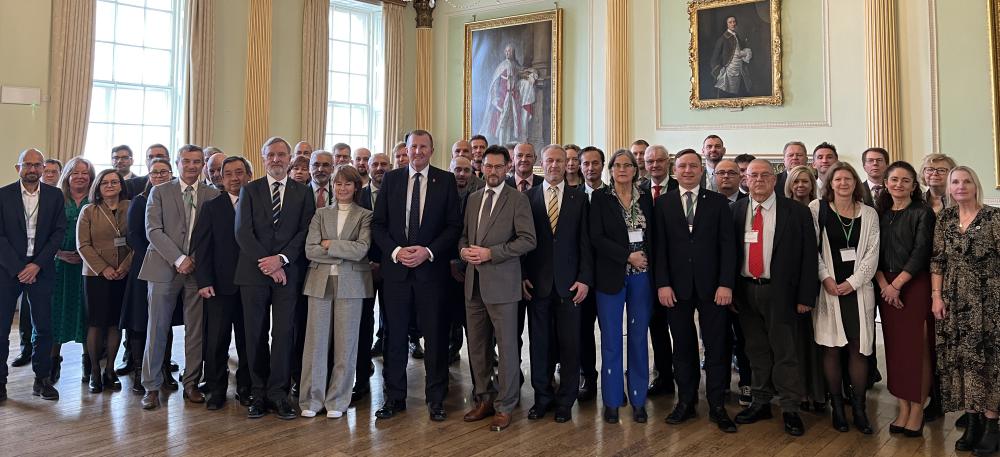
The Western European Nuclear Regulators’ Association (WENRA) came together for its Fall Plenary meeting on 6th and 7th November, hosted by the Office for Nuclear Regulation (ONR), in Bath, United Kingdom. WENRA members work as a collective group of national nuclear regulators in support of its mission to continuously improve and harmonise nuclear safety to as high as reasonably practicable levels.
A number of important topics were discussed. A consistent theme during the Plenary meeting was how WENRA could broaden its influence and strengthen its relationships, given the changing global environment and its goal to continue to have a positive impact on the nuclear industry. It was recognised that this would require closer collaboration with others on key topics of priority aligned to the WENRA Strategy, whilst also agreeing that the existing criteria for assessing new observers and associate members applications to join WENRA remains appropriate.
In the interests of strengthening relationships, WENRA welcomed senior representatives from the European Nuclear Installation Safety Standards (ENISS) and the European Technical Safety Organisations Network (ETSON) for a joint session aimed at better understanding each other’s organisations and work programmes, as well as to explore potential areas for closer collaboration, harmonisation and convergence of approaches which would serve to reduce duplication and improve efficacy. Initial focus will be through existing working groups, with targeted cooperation on Small Modular Reactors (SMRs) and passive systems also agreed, live topics currently common for all three organisations. Progress on this work will be presented to the WENRA Plenary at its next meeting in May.
The Plenary received a comprehensive update on the latest situation in Ukraine and the significant challenges faced by the State Nuclear Regulatory Inspectorate of Ukraine (SNRIU). This included a report on Ukraine's power distribution system, the status of nuclear facilities at Chernobyl and the continued occupation by the Russian Federation of Zaporizhzhia Nuclear Power Plant (NPP). WENRA discussed the ongoing impact of the war, how the conflict and illegal occupation does not serve the best interests of nuclear safety, and the concerns associated with any future restart of reactor Units at ZNPP.
Among WENRA’s working groups updates, members reported significant progress toward the harmonisation of the suite of WENRA Safety Reference Levels (SRLs), removing duplication and overlap. The work will complete early 2026, when the SRLs will be frozen, providing stability of requirements and expectations for legal and regulatory frameworks.
The Plenary discussed a draft summary report on the different approaches amongst its members on the use and application of high quality industrial grade items, with common and diverse practices evident. Work will continue on developing a good practice guide, with a set of basic principles that should be adopted to establish a solid foundation when considering the use and application of industrial grade items. This document will be published towards the end of 2026.
Aligned to WENRA’s strategic objective to establish and adopt good practices to regulatory cooperation for the review and assessment of new technologies, work continues on developing an approach to generic assessment of concept designs for new reactor technologies that could be adopted by the wider regulatory community. A workshop will be held in Spring 2026, with all members encouraged to participate, in readiness for a fuller discussion at the next WENRA Plenary in May. The goal is to have more consistent regulatory reviews of reactor concepts across Members, enabling better leveraging and sharing of design assessments conducted by regulators, more standardised reactors designs, and ultimately strengthened nuclear safety.
Work also continues on the important question ‘How Safe is Safe Enough,’ focusing on the continued protection of the public, especially in the context of Small Modular Reactors and their potential siting closer to population centres. The Plenary acknowledged this is a complex issue and whilst work had progressed over the summer, this is still in the early stages. WENRA’s Reactor Harmonisation Working Group (RHWG) will revisit its work on this issue and explore the potential use of case studies to establish a series of high-level principles on the deployment of new reactor designs, along with highlighting any challenges WENRA would need to consider.
Two common positions were discussed, with final published positions expected by end December 2025. The first relates to NPP lifetime extension reflecting WENRA’s commitment to ensuring that ageing management is systematically addressed, and that governments, regulators, and operators each fulfil their responsibilities to support transparent, well-informed, and safety-driven decisions on lifetime extensions. The second common position relates to public participation in the Periodic Safety Review (PSR) process for NPP. Because of the differing purposes of the PSR and the different roles of the PSR in national regulatory frameworks, the statement recognises that public participation will need to be implemented in a way that fits national legal boundary conditions.
Preparations for the Topical Peer Review III (TPR III), which is a requirement under the Nuclear Safety Directive, were discussed following confirmation from the European Nuclear Safety Regulators Group (ENSREG) that WENRA should be the organisation involved in its preparations. WENRA will begin with formulating a list of candidate topics for ENSREG’s consideration during 2026. WENRA emphasised the importance of learning the lessons from the previous TPRs and on ensuring TPR III delivers value for Member States.
WENRA Chair succession arrangements were agreed, with Mark Foy, (ONR) standing down at the end of the year following his retirement, and Petteri Tiippana, Radiation and Nuclear Safety Authority (STUK) confirmed as the new WENRA Chair from January 2026 for a two-year term.
Overall, it was a productive two days that saw WENRA members working collaboratively on several important issues relevant to the continued nuclear and radiation safety of an increasingly dynamic industry.